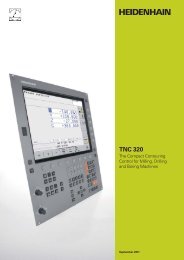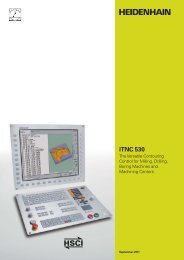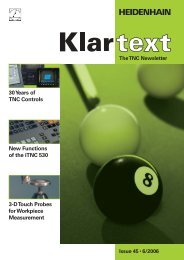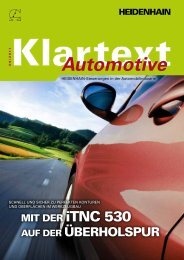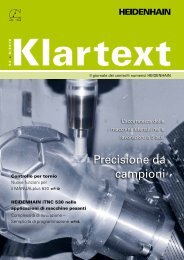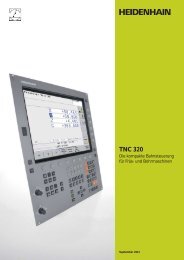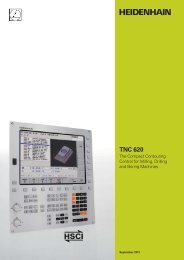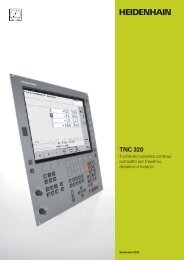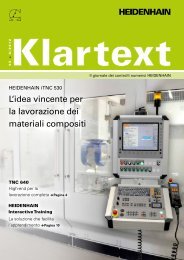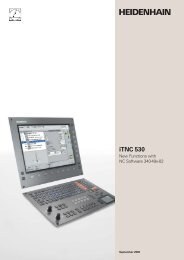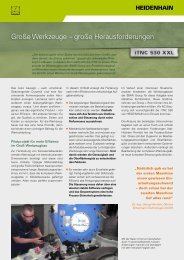Klartext 47 - TNC 640 - Heidenhain
Klartext 47 - TNC 640 - Heidenhain
Klartext 47 - TNC 640 - Heidenhain
Create successful ePaper yourself
Turn your PDF publications into a flip-book with our unique Google optimized e-Paper software.
<strong>Klartext</strong> + Issue <strong>47</strong> + 09/2007 1<br />
Describing contours with ICP<br />
You describe workpieces or contours<br />
with the interactive graphics of the ICP<br />
contour editor. You create the contour<br />
by entering the elements step-by-step.<br />
When selecting the contour elements,<br />
you already specify the direction of the<br />
line or the direction of rotation of the<br />
circular arc. This way the MANUALplus<br />
needs very little information about the<br />
contour element. The MANUALplus<br />
calculates missing coordinates, intersections,<br />
circle center points, etc. In most<br />
cases you can describe the workpiece<br />
Contour follow-up:<br />
Another highlight of the MANUALplus<br />
620 is the contour follow-up feature.<br />
If you define the workpiece blank<br />
at the beginning of your smartTurn<br />
program, the control then computes<br />
the new blank for each following cycle.<br />
The machining cycles are adapted automatically<br />
to the current workpiece<br />
blank. They are so intelligent as to<br />
avoid air cuts and to optimize approach<br />
paths, even if the workpiece material<br />
has been previously removed.<br />
Unit selection:<br />
smartTurn also provides special machining<br />
units to go along with those for<br />
turning, drilling and milling machining.<br />
You define global program parameters,<br />
such as oversizes, safety clearances,<br />
coolants, etc., in the start unit. smart-<br />
Turn then transfers these parameters<br />
to the other units.<br />
with the dimensions given in the production<br />
drawing. If there are multiple<br />
solutions, ICP displays the mathematically<br />
possible variants from which you<br />
can select the correct solution.<br />
Importing DXF:<br />
It’s even easier when the workpiece<br />
drawing is already in DXF format, since<br />
with ICP you can import contours available<br />
in DXF format. Not only does this<br />
save time otherwise spent on testing,<br />
but you can also be sure that the finished<br />
contour is exactly according to<br />
the designer’s specifications.<br />
You can use the smartTurn units to<br />
realize the entire lathe machining operation,<br />
as well as drilling and milling<br />
operations with the C axis. However,<br />
if you want to control special machine<br />
components or use variable programming,<br />
then DIN PLUS programming is<br />
the answer. You use DIN PLUS to realize<br />
functions that are not provided by<br />
smartTurn. A significant advantage of<br />
the MANUALplus 620 is that it enables<br />
you to switch between the smartTurn<br />
and DIN PLUS programming modes<br />
within an NC program.<br />
Unit as form:<br />
Unit as NC program:<br />
The tool and technology<br />
database<br />
Tried-and-true features of the<br />
MANUALplus include the saving of<br />
tool and cutting data, as well as simple<br />
determination of setting dimensions.<br />
The tool database of the MANUALplus<br />
620 not only provides greater<br />
capacities and easily understood dialogs<br />
for data entry, but the MANUALplus<br />
620 also supports placement of<br />
tools in the turret.<br />
If you want to change the tool assignment<br />
or the tools in the turret, you can<br />
additionally display the tools currently<br />
in the turret in the upper window, and<br />
the entries of the tool database in the<br />
lower window. Now you need only<br />
select the turret pocket and choose<br />
the correct tool from the database.<br />
You can transfer the tool data to the<br />
turret assignment entry with a simple<br />
keystroke.<br />
With the MANUALplus 620, you also<br />
need enter the cutting data only once.<br />
The technology database saves the<br />
cutting data according to the criteria<br />
of workpiece material, cutting material<br />
and machining mode. Thanks to this<br />
three-dimensional table, the control<br />
always knows the appropriate feed<br />
rate and the correct cutting speed.<br />
The MANUALplus 620 determines<br />
the machining mode from the cycle<br />
or with smartTurn from the unit. The<br />
cutting material is defined in the tool<br />
description. You need only define the<br />
workpiece material at the beginning<br />
of the cycle program or the smartTurn<br />
program, and the technology database<br />
will propose the correct values for your<br />
machining operation. You can use the<br />
suggested cutting parameters or adjust<br />
them if required.



